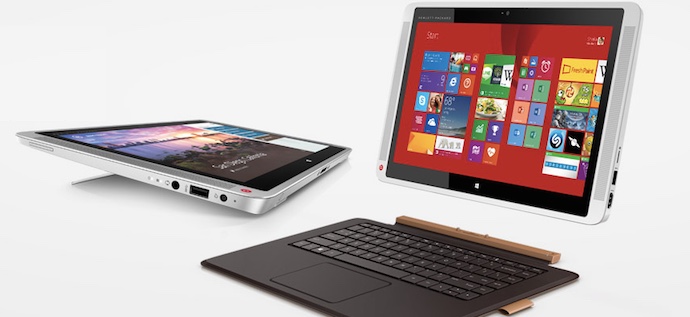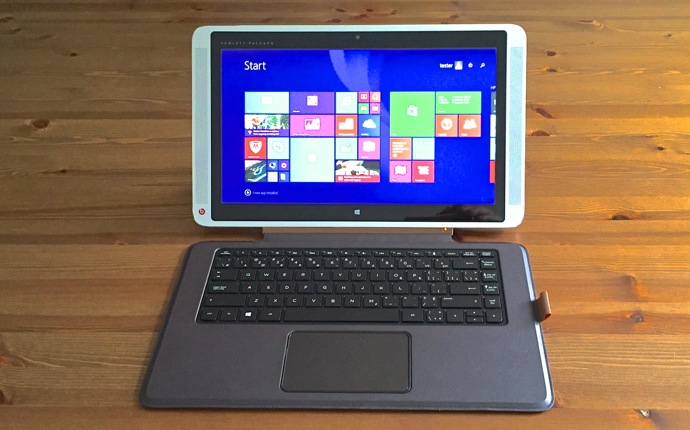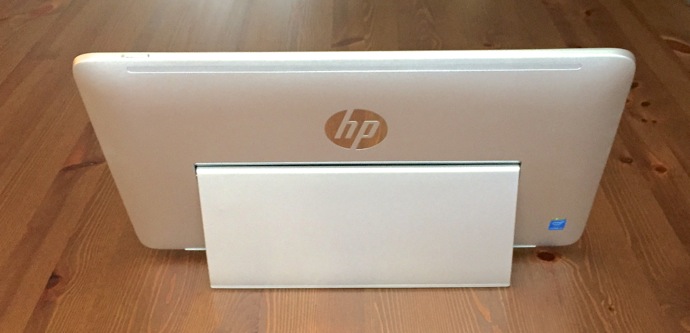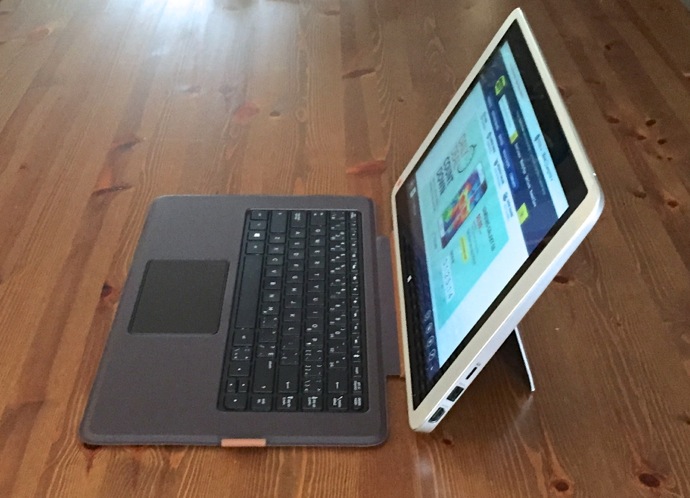
Most consumer tablets have displays in the 8-inch to 10-inch size range. Microsoft tapped the prosumer and professional market when it released the big screen Surface Pro line of tablets that convert to a PC laptop form factor. HP—one of the world’s largest PC manufacturers—offers its own take on that the 2-in-1 convertible laptop form factor. The Envy x2 13.3, a very big Windows tablet with features Surface fans will find familiar, namely a kickstand, digital pen support and a magnetically attached keyboard cover. The approach is familiar, but the Envy x2 is a different beast from the Surface Pro (and new Surface), as I found out during my review period.

|
HP Envy x2 13.3 Specs (as Tested)
You can read the full specifications on the Envy x2 product page. |
First Impressions
I’m willing to bet my first thought after unboxing the HP tablet was probably the same most people would have: “Wow, this is one big tablet.”
It’s hard to get past that initial impression.
I’ve used tablets aimed at the professional crowd before (like the Surface Pro 3 and Samsung’s GalaxyPRO 12.2), but the Envy still makes an impression. It has a larger display than both of those tablets, and it’s also considerably thicker.
It’s an attractive looking device, clad in silver aluminum with dual speaker grills framing the sides of that wide display and a prominent red BeatsAudio logo (probably one of the last HP computers released under that partnership before Apple purchased Beats).
At the back, is an adjustable kickstand, similar to that found on the Surface Pro.
Also included in the box is a soft keyboard cover with magnetic attachment, similar to the Surface Type keyboard—only this one is included, not an added cost extra.
A quick glance at the edges of the Envy x2 show that it is well equipped with expansion ports, including dual USB. It’s worth noting that unlike most tablets, it lacks a camera on the back, so no holding this thing up to snap photos. It does have a Full HD web cam for video conferencing.

User Experience
The HP Envy x2 isn’t going to set any speed records if you start loading it up with processor-hogging software like Photoshop. It’s also not suitable for anything but casual gaming.
The choice to go with a Core M mobile CPU is a tradeoff that lets this convertible laptop run Windows 8.1 and Windows software, but keeps it from being a high powered performer. But that Core M CPU means there is no fan, so this convertible laptop runs completely silent—unless you choose to crank up the BeatsAudio sound system.
Having 8GB of RAM on tap means you can have multiple windows open and that 256GB SSD means fast disk access and plenty of room for storage (although much less than you’ll find on a traditional laptop), but it’s best to consider this an all-purpose PC.
Basically, the 13.3-inch HP Envy x2 falls somewhere between the new Microsoft Surface 3 and the Surface Pro 3.

It has the Core M processor like the Surface 3, instead of a Core 13, Core i5 or Core i7 powering the Surface Pro 3. But its display size dwarfs the Surface 3’s (and is a bit larger than the Surface Pro 3) and like the Surface Pro 3 the adjustable kickstand has a full range of motion instead of being limited to several presets. In terms of price, it also straddles the two Microsoft product lines, although the Envy x2 costs considerably less than a loaded Surface Pro 3.
The display is a responsive touchscreen with Full HD resolution. It’s also a 16:9 aspect ratio display. Think wide and narrow. That’s ideal for watching HD movies, but it means more scrolling in laptop mode and it is very awkward to hold as a tablet.

The Keyboard
Like the Microsoft tablets, the HP Envy X2 transforms into laptop mode using a soft cover, Bluetooth keyboard. The keys are full-sized, backlit, chiclet style with enough travel to make typing a pleasant experience.
Connectivity is via Bluetooth and—also like the Surface tablets—there is a magnetic attachment option that connects the keyboard to the bottom of the tablet to create a laptop form factor. Physically connecting the two is also the method for recharging the keyboard. Like the Surface tablets, I wouldn’t actually use this arrangement on my laptop, but it works quite well on a flat surface.
Unlike Microsoft, HP includes the keyboard instead of making it an optional, added-cost purchase.
Two notes on the Envy x2 keyboard. It’s a bilingual version, which means some of the keys are rather busy in terms of labeling. I also had an issue during initial setup where the keyboard paired (and worked for several screens), then balked and refused to be recognized. It still showed as being paired in the Bluetooth settings, but kept throwing up an error message that was half in English, half in French. I finally resorted to un-pairing the keyboard and re-pairing and it behaved perfectly after that.
Worth Lugging Around?
That’s the key question when it comes to the HP Envy x2.
There are a growing number of 13-inch Ultrabooks like the Dell XPS 13.3 that offer the same size touchscreen as the Envy x2 along with advantages like a superior keyboard and more powerful Intel Core i5 CPU—and still weigh considerable less (that Dell is just 1.26 kg).

But with these ultra-light Ultrabooks, you don’t get the Envy X2’s ability to ditch the keyboard altogether and convert to a Windows tablet.
On the other hand, if you like the convertible laptop form factor, but find the 13.3-inch display is limiting, you can buy a version of the HP Envy x2 with a 15.6-inch display! I can’t even imagine using something like that in tablet mode, but I’m sure there are some professionals who would find that real estate and a digital stylus to be an awesome combo.
I wrote a post a few days ago about being able to survive with using a tablet as your sole device. The HP Envy x2 is one of those devices that makes such a move possible. Anyone looking for a convertible PC that can replace both a laptop and a tablet—without giving up a large display or Windows 8—should add the HP Envy x2 13.3 to their short list. It’s definitely worth shopping against competitors like the Surface 3 and Surface Pro 3.



